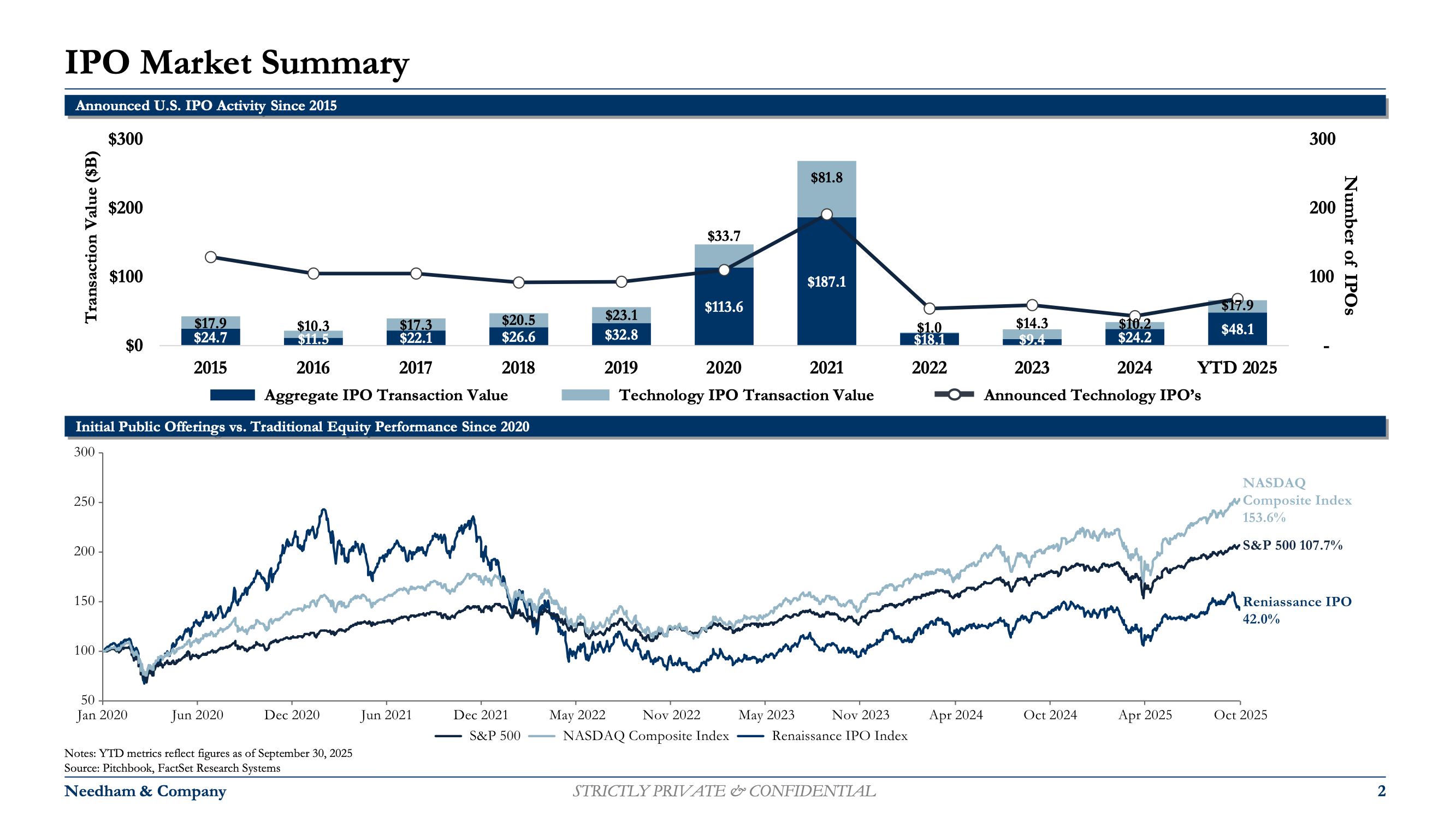If you're building a B2B SaaS company, good news: the market finally has the wind at its back again. Since May 2025, the tech IPO window has decisively reopened, large-cap buyers are back on the hunt, and AI is rapidly reshaping what gets funded and acquired.
Our friends at Needham & Company joined us for a discussion covering the state of M&A, and how founders can prepare for an exit. Here's what they had to say.

Why a Strong Exit Market Matters to Founders
The health of the public market isn't just about late-stage companies — it’s the liquidity engine of the entire startup ecosystem. When IPOs work, capital and confidence immediately cascade down to fuel investment at all levels, from growth rounds to Series B, and critically, even to Seed.

This market shift impacts early-stage B2B SaaS founders, too: newly public companies become cash- and stock-rich, turning them into active acquirers who seek to buy products that accelerate their roadmaps, often via focused tuck-ins where early-stage startups shine. Furthermore, successful new issues provide clear public market comparables (public comps), which reset valuation signals, narrowing bid-ask spreads in the private market and making later funding rounds and eventual exits significantly more actionable.
Key Market Takeaways
The current market presents a complex but generally positive picture. Here are the core takeaways at a glance:
- IPOs: Tech issuance rebounded post-May, with aftermarket performance showing strong results. Select 2024–2025 cohorts are trading materially up from their initial offer price.
- M&A: Deal value is up ~30% year over year, though this increase is driven primarily by $10 billion+ transactions. Smaller add-on deals are improving, but the lower-middle-market software segment remains uneven.
- Private Capital: There is an uptick in funding for both Series A and pre-IPO rounds. However, the crucial Series B stage has tightened, now demanding more structure and rigorous diligence.
- AI is the Outlier: Companies with true AI differentiation earn premium checks and often trigger "unnatural" buyer behavior, while superficial AI narratives are no longer passing diligence.
The New Rules: Quality, Retention, and Structure
Forget the growth-at-all-costs mindset of 2020–2021. Today's market is defined by a flight to quality, where buyers prefer paying a premium for durable, de-risked assets over “cheap but complicated” bets. Gross Dollar Retention (GDR) is the new king, serving as the top determinant of value; best-in-class is now ~95%+ GDR. While Net Dollar Retention (NDR) still matters, upsell-driven stories are heavily discounted if the underlying churn is leaky.
Finally, structure is back. Expect more formal processes in post-A rounds, often including preferences and ratchets. Diligence timelines are longer, with a fierce focus on clear KPIs and proof over promise.

How AI is Reshaping M&A and Fundraising
AI is fundamentally changing the calculus for both investors and acquirers. Strategics are evaluating teams much earlier now, requesting details on engineering orgs, titles, and compensation — they want proof that your team can build and ship novel AI.
Consequently, horizontal SaaS without a clear AI advantage faces significant headwinds unless it can demonstrate a combination of proprietary data, 50%+ growth with profitability, and elite retention. It’s important to remember that Agentic AI won’t kill SaaS; enterprises still need systems of record, governance, and packaged workflows. AI is a feature and multiplier, not a wholesale replacement.
Practical Moves for Founders in the Next 2–3 Quarters
Your job now, as a founder and CEO, is to create optionality through execution and preparedness. Here are four practical areas of focus:
- Raise your market profile early: Start relationship-building 2–3 quarters before you need capital. Join curated investor/strategic showcases and partner programs (e.g., Salesforce, Microsoft) to accelerate trust and feedback loops.
- Make your AI story real: Ship one SKU or feature with measurable usage. Track its cohort adoption, retention lift, and upsell impact — even if revenue attribution is small today. You must meticulously document your data advantage, including sources, access rights, security posture, and model choices; "AI" in the name alone won't pass diligence.
- Operate to today’s valuation framework: Target 95%+ GDR and fix churn drivers before chasing upsell. Show a clear path to dollar EBITDA profitability in 12–24 months, understanding that Rule of 40 quality matters more than the headline number. Furthermore, manage concentration: having >20–30% with a single customer will meaningfully narrow your buyer universe.
- Build optionality into your cap table and plan: If you raised in the frothy 2021–2022 period, assume benchmarks haven’t fully recovered. Structure and inside bridges are common to grow into prior valuations. Keep "platform + M&A" narratives ready, as sponsors pay for a high-quality core plus a credible, accretive tuck-in roadmap.
Exits and Process: The Path to Value
Knowing when to consider an earlier exit is key. A sale makes sense if you have strong GDR, clear product-market fit in a focused niche, and a feature or team that is strategically critical to a larger acquirer. This is particularly true if you can be a "needle-mover" tuck-in for a newly public company or a PE platform, and your realistic growth, dilution, and risk-adjusted proceeds favor a sale over multiple uncertain structured rounds.
What great processes look like now involves wide aperture and real competition. The currency of the deal is credibility — achieved by setting conservative guidance and consistently outperforming. Finally, use earnouts as a last resort, and if used, they must be tied to seller-controlled milestones; prefer rollover equity pari passu (on equal footing) with the sponsor for true alignment.
The Bottom Line
The market is open — but it is highly selective. Quality, retention, real AI, and prepared storytelling win every time. Your core job today is to create options: more buyers, more data-driven proof, and more credible paths to value. Start the conversations now. The founders who build trust before they need it will have the most choices when it counts.
